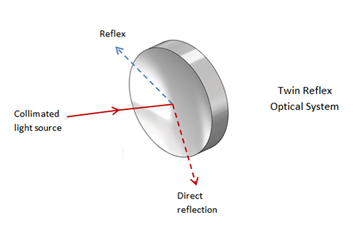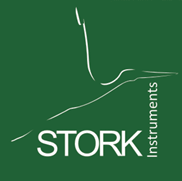The STORK Split-Beam Reflex chilled-mirror sensor measures the dewpoint of gases with great accuracy by detecting the deposition of a dew or frost on a tiny mirror which is cooled by a Peltier element. The unique feature of this instrument is its optical system. This detects whether the phase of the condensed layer on the mirror surface is ice or super-cooled water. Super-cooled water may be present at temperatures as low as -48ºC. In an instrument which uses the chilled mirror principle, it is important therefore that the optical system should detect the phase of the condensed layer. This fact is dramatically demonstrated by a simple example. At a dewpoint of -48ºC the water vapor pressure of a gas is 5.0613 Pa when measured over ice and 8.1226 Pa when measured over super-cooled water. This is equivalent to a difference of more than 4 degrees of dewpoint! Stork's unique split-beam reflex optical system overcomes this difficulty.
A ray of light shines at the mirror surface at a very narrow angle to its plane. Reflections from the mirror are split into two beams and captured at two different positions on the mirror's periphery by photo-detectors. Detector A receives directly reflected light from the mirror surface, while Detector B captures light reflected from condensed water droplets or ice crystals depending on the given phase. The quantity of reflected light arriving at the two detectors differs according to whether ice or water is present on the mirror surface. Specially designed software recognizes this and also differentiates between super-cooled water and water that is at a temperature above the freezing level.
 |
The photo-detectors and Peltier element work in a closed loop arrangement such that the dew or frost on the mirror surface modulates the light arriving at the detectors. The Peltier power is regulated by the optical system in such a way as to provide more or less cooling to the mirror. The system works in a continuous balance such that a thin layer of dew or frost is permanently maintained on the mirror surface during measurement. A four wire platinum resistance element measures the mirror temperature - the effective dewpoint.
A further important feature of the STORK split beam reflex sensor is its AZOR Automatic Zero Optical Reset. This compensates automatically for changes in the mirror surface which arise from short term contamination carried by the sample gas and from long term changes in the reflectivity of the mirror caused by accumulated abrasions. At regular intervals the optical system departs measuring mode and enters AZOR mode, which is a sequence of events designed to clean the mirror surface and automatically zero the optical measurement system.
|
The AZOR sequence:
|
The split-beam reflex optical system is installed in the STORK DEWRay portable dewpointmeter, the STORK DEWRay portable and STORK Ultra precision calibration dewpointmeter.
|
How does the STORK chilled mirror sensor differ from chilled mirror sensors made by our competitors?
Most chilled mirror dewpoint hygrometers made by our competitors ignore the question of super-cooled water. They assume that ice is always present when the dewpoint is below 0ºC.This means that the instrument could give a reading that is erroneous by up to 4ºC dewpoint. Some competitor's instruments have a pre-cool function which cools the mirror well below the assumed dewpoint in order to encourage ice formation, but there is no guarantee that this method succeeds in all cases. Others employ a microscope which allows observation of the mirror by human eye.
As explained earlier, the STORK Split-Beam Reflex system detects the actual conditions on the mirror surface and whether ice or super-cooled water is present. It does this rapidly and completely automatically, requiring no human eye observation or forced cooling of the mirror. It therefore guarantees that errors due to the unknown presence of supercooled water are eliminated. |
